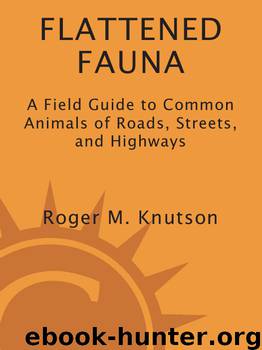Flattened Fauna, Revised by Roger M. Knutson

Author:Roger M. Knutson [Knutson, Roger M.]
Language: eng
Format: epub
ISBN: 978-0-307-81431-9
Publisher: Ten Speed Press
Published: 2013-11-19T16:00:00+00:00
Starlings (Sturnus vulgaris vulgaris)
8-inch body, 12-inch wings
HABITS AND ABUNDANCE This European immigrant has made a place for itself, both in cities and countryside, more rapidly than anyone would have thought possible. In 1880, about eighty birds were introduced into New York City; now you can find that many in your back yard. Reportedly they were brought in to satisfy the whims of a Shakespeare Society that wanted all the birds mentioned in Shakespeare’s plays to live everywhere on earth where the plays might be read or performed. We should probably continue to honor Shakespeare, but not necessarily his fans. By now, the starling is at home in the most thoroughly urban settings, and it is noisy, dirty, and pugnacious enough to drive other birds out of the neighborhood. (Its Latin name, Sturnus vulgaris vulgaris, fits both its commonness and its habits.) Many people view a starling on the road as worth at least two in the trees. Sheer numbers help explain why they are so abundant in the road fauna, but their catholic eating habits also contribute. Like many insect-eating birds, they feed on the road when pickings are slim in other places. Starlings are especially likely to be found spread out on the street during the nesting season, when they collect large numbers of insects to feed their developing young.
FIELD MARKS AND RANGE Starlings live nearly everywhere in the U.S., and they are present year-round over all but the northernmost parts of that range. If bill color can be determined at usual urban speeds, it is the best single field mark during the summer months, when the starling is the only black bird with a yellow bill. In winter the bill is dark, and the bird is heavily speckled. The mottled plumage, smaller size, shorter tail and urban proclivities will distinguish it from grackles and cowbirds. Most grackles and cowbirds migrate, however, so they aren’t around when the starling is black-billed. Young starlings are only slightly mottled and nearly brown with lighter underparts. They are much more likely than adults to be found on the road. In most urban situations, any uniformly dark to slightly speckled bird about eight inches long is likely to be a starling. The wings, which are uniform black in the summer and brownish in the winter, often flap for days in the airstream of passing cars and trucks.
Download
This site does not store any files on its server. We only index and link to content provided by other sites. Please contact the content providers to delete copyright contents if any and email us, we'll remove relevant links or contents immediately.
Sapiens: A Brief History of Humankind by Yuval Noah Harari(14321)
The Tidewater Tales by John Barth(12627)
Mastermind: How to Think Like Sherlock Holmes by Maria Konnikova(7279)
Do No Harm Stories of Life, Death and Brain Surgery by Henry Marsh(6908)
The Thirst by Nesbo Jo(6882)
Why We Sleep: Unlocking the Power of Sleep and Dreams by Matthew Walker(6657)
Life 3.0: Being Human in the Age of Artificial Intelligence by Tegmark Max(5518)
Sapiens by Yuval Noah Harari(5325)
The Longevity Diet by Valter Longo(5043)
The Body: A Guide for Occupants by Bill Bryson(5030)
The Rules Do Not Apply by Ariel Levy(4911)
The Immortal Life of Henrietta Lacks by Rebecca Skloot(4552)
Animal Frequency by Melissa Alvarez(4428)
Why We Sleep by Matthew Walker(4394)
The Hacking of the American Mind by Robert H. Lustig(4341)
Yoga Anatomy by Kaminoff Leslie(4333)
All Creatures Great and Small by James Herriot(4272)
Double Down (Diary of a Wimpy Kid Book 11) by Jeff Kinney(4242)
Embedded Programming with Modern C++ Cookbook by Igor Viarheichyk(4141)
